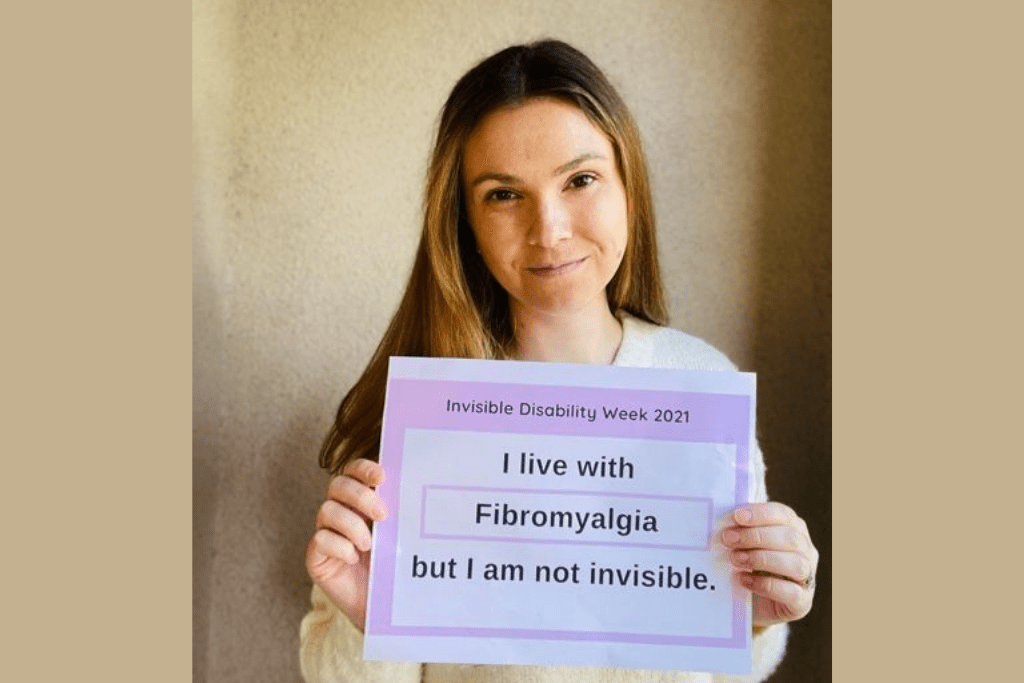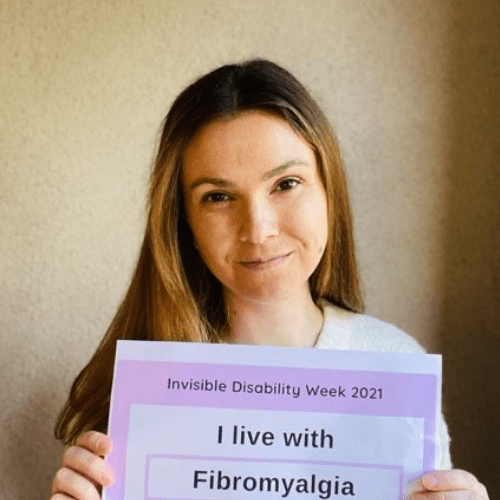
[vc_row][vc_column][vc_column_text]
Allison lives with chronic pain since 2012. In 2019 she was diagnosed with fibromyalgia. She is a blogger and educator, if you would like to have a look at her posts you can find her on Instagram or go straight to her website. Read her story of living with an invisible disability below.
I hid my disability for a long time. Actually, I am still coming to terms with the fact that I even have a disability. You see, I don’t use a wheelchair or other mobility aid like a cane or walker. I’m a young, 20-something woman; there is nothing about my appearance that would suggest I have a disability yet, I do.
If you live with a hidden or invisible disability, please hear this. You are seen. You are heard. Your disability is valid.
[/vc_column_text][/vc_column][/vc_row]
If my doctors didn’t believe me, why would anyone else?

Raising awareness of hidden disabilities
Being an active part of the chronic illness community, I know I am not alone in the struggle those with invisible disabilities go through to be believed by their doctors, family, friends, co-workers, and even strangers. We aren’t looking for sympathy or attention. We simply want to acknowledge that our disability is real and valid despite our outward appearance.
I feel lucky to have family, doctors, and a whole fantastic community of spoonies behind me who believe in my invisible condition, but others are not as fortunate. Family members view them as lazy, friends as flaky, and doctors as dramatic.
This needs to change.
The more we raise awareness for hidden disabilities, the more we help the invisible become visible. We need to teach people that behind a put-together outward appearance, maybe a person struggling physically or mentally. And to do that requires stepping out from behind the curtain.
I know firsthand just how scary it can be to let someone in and reveal what has been hidden from them—the fear of backlash, scepticism, losing a friend, or even the security of a job. But, if we keep hiding, we don’t give people the chance to believe, support, and encourage us!
I still encounter people who don’t believe fibromyalgia is a legitimate condition. It’s an old people’s disease or something a hypochondriac makes up. I’ve heard and seen it all now. But I’m not letting that stop me. I feel a sense of responsibility to advocate not only for myself but for others who are doubted or ridiculed.
If you live with a hidden or invisible disability, please hear this. You are seen. You are heard. Your disability is valid.
[/vc_column_text][/vc_column][/vc_row]
Our “covers” are often pristine for those with an invisible illness—no nicks or tears, colour still bright, inviting, and welcoming. Open the book up, though, and you might get a different story; scars beneath the surface are revealed, crumpled pages with rips and scratches. The problem is most people don’t even bother to open up the book.
The struggles of living with a hidden disability
Because we often think what you see is what you get, those with invisible disabilities often struggle with being believed. This is precisely why I kept my disability under wraps. I worked hard teaching all day but would come home and suffer in pain. When I finally confided in one of my co-workers about my fibromyalgia diagnosis, she told me, “I hid it well.” However, when I thought more about her comment, it made me wonder if she believed me.
Doctors had unfortunately planted these seeds of doubt over the years. I remember the anxiety of walking into a new doctor’s office. I would think to myself, “Would they believe me this time?” And the answer often varied. In some cases, my pain was acknowledged but brushed off as stress. Some doctors said all my test results came back normal, so there was no need to look further. Another doctor suggested I may have fibromyalgia but followed it up with, “I think my mother has it, but she’s a little crazy, so who knows.”
If my doctors didn’t believe me, why would anyone else?




Raising awareness of hidden disabilities
Being an active part of the chronic illness community, I know I am not alone in the struggle those with invisible disabilities go through to be believed by their doctors, family, friends, co-workers, and even strangers. We aren’t looking for sympathy or attention. We simply want to acknowledge that our disability is real and valid despite our outward appearance.
I feel lucky to have family, doctors, and a whole fantastic community of spoonies behind me who believe in my invisible condition, but others are not as fortunate. Family members view them as lazy, friends as flaky, and doctors as dramatic.
This needs to change.
The more we raise awareness for hidden disabilities, the more we help the invisible become visible. We need to teach people that behind a put-together outward appearance, maybe a person struggling physically or mentally. And to do that requires stepping out from behind the curtain.
I know firsthand just how scary it can be to let someone in and reveal what has been hidden from them—the fear of backlash, scepticism, losing a friend, or even the security of a job. But, if we keep hiding, we don’t give people the chance to believe, support, and encourage us!
I still encounter people who don’t believe fibromyalgia is a legitimate condition. It’s an old people’s disease or something a hypochondriac makes up. I’ve heard and seen it all now. But I’m not letting that stop me. I feel a sense of responsibility to advocate not only for myself but for others who are doubted or ridiculed.
If you live with a hidden or invisible disability, please hear this. You are seen. You are heard. Your disability is valid.
[/vc_column_text][/vc_column][/vc_row]
You know the age-old saying, “Don’t judge a book by its cover?” We are often taught it in school, with the message of being kind to one another and not making assumptions about people before we truly know them. But, somewhere along the way into adulthood, we began to lose sight of this wise quote by Mary Ann Evans. Unfortunately, for those with an invisible disability, we bear the sting of a book judged by its cover all too often.
What is an invisible disability?
An invisible disability, also called a hidden disability, is a chronic illness or condition that impairs the function of someone’s everyday life. You usually cannot see the disability from the person’s outward appearances hence why it is “invisible.”
Our “covers” are often pristine for those with an invisible illness—no nicks or tears, colour still bright, inviting, and welcoming. Open the book up, though, and you might get a different story; scars beneath the surface are revealed, crumpled pages with rips and scratches. The problem is most people don’t even bother to open up the book.
The struggles of living with a hidden disability
Because we often think what you see is what you get, those with invisible disabilities often struggle with being believed. This is precisely why I kept my disability under wraps. I worked hard teaching all day but would come home and suffer in pain. When I finally confided in one of my co-workers about my fibromyalgia diagnosis, she told me, “I hid it well.” However, when I thought more about her comment, it made me wonder if she believed me.
Doctors had unfortunately planted these seeds of doubt over the years. I remember the anxiety of walking into a new doctor’s office. I would think to myself, “Would they believe me this time?” And the answer often varied. In some cases, my pain was acknowledged but brushed off as stress. Some doctors said all my test results came back normal, so there was no need to look further. Another doctor suggested I may have fibromyalgia but followed it up with, “I think my mother has it, but she’s a little crazy, so who knows.”
If my doctors didn’t believe me, why would anyone else?




Raising awareness of hidden disabilities
Being an active part of the chronic illness community, I know I am not alone in the struggle those with invisible disabilities go through to be believed by their doctors, family, friends, co-workers, and even strangers. We aren’t looking for sympathy or attention. We simply want to acknowledge that our disability is real and valid despite our outward appearance.
I feel lucky to have family, doctors, and a whole fantastic community of spoonies behind me who believe in my invisible condition, but others are not as fortunate. Family members view them as lazy, friends as flaky, and doctors as dramatic.
This needs to change.
The more we raise awareness for hidden disabilities, the more we help the invisible become visible. We need to teach people that behind a put-together outward appearance, maybe a person struggling physically or mentally. And to do that requires stepping out from behind the curtain.
I know firsthand just how scary it can be to let someone in and reveal what has been hidden from them—the fear of backlash, scepticism, losing a friend, or even the security of a job. But, if we keep hiding, we don’t give people the chance to believe, support, and encourage us!
I still encounter people who don’t believe fibromyalgia is a legitimate condition. It’s an old people’s disease or something a hypochondriac makes up. I’ve heard and seen it all now. But I’m not letting that stop me. I feel a sense of responsibility to advocate not only for myself but for others who are doubted or ridiculed.
If you live with a hidden or invisible disability, please hear this. You are seen. You are heard. Your disability is valid.
[/vc_column_text][/vc_column][/vc_row]



